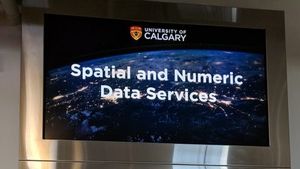[This is 3. Here is 1 and 2.]
I was pleased to participate in LITA’s Top Tech Trends panel at ALA this year (see the video and live coverage).
We were each asked to talk about three trends: current, a bit further out, and a bit further out again. In thinking about the exercise, it seemed to me that it would be interesting to talk about how services are being reconfigured in a network environment, and not just focus on technology as such. We had three minutes in which to discuss each trend.
My third trend was somewhat diffuse and was inspired by a remark I read a couple of years ago by Gavin Potter, a contestant in the competition NetFlix ran to improve its algorithm.
“The 20th century was about sorting out supply,” Potter says. “The 21st is going to be about sorting out demand.” The Internet makes everything available, but mere availability is meaningless if the products remain unknown to potential buyers. [This Psychologist Might Outsmart the Math Brains Competing for the Netflix Prize]
Libraries spend a lot of time sorting out supply. The fragmentation of supply (across suppliers, databases, formats, business models, etc) has meant that we have created quite a complex staff, systems and service environment to cope. Furthermore, this has evolved piecemeal to manage evolving patterns of provision. There are separate workflows and supply industries for bought materials (think the integrated library system and catalog), for licensed materials (think knowledge base, a to z lists, metasearch, ERM), and for digital materials (think repository infrastructure). What is more this infrastructure is institution-scale – it is repeated in each library. There is significant workflow and systems redundancy across libraries. At the same time, large buildings have also been required to support this supply, as the model has perforce been to assemble materials close to the user.
This focus on supply has been because the transaction costs – in time, effort or money – for a university, or a student or faculty member, or a member of the public, of interacting with the range of information sources is quite high, and a major role of the library is to reduce those costs by integrating the sources of supply and bringing them close to the user.
However the transaction costs for the user have come down. Google has been a major part of this. But so has the general consolidation in a network environment: Amazon, Google Books, the discovery layers I mentioned as my second trend, Worldcat, and so on.
As supply consolidates, attention shifts to sorting out demand. Of course, libraries have always worked here, but not as much as they might have. What might this mean in our increasingly digital environment? Here are some overlapping examples:
- Ranking, relating, recommending. We are used to systems which provide hints and hooks for us, which guide us through large collections, which make suggestions. We get alerts, reminders, recommendations. Often, sites will mobilize four sources of metadata (professional, contributed, automatic, and usage) to build such functions into their services. [A related blog entry: Recommendation and Ranganathan – retread]
- Community is the new content. We expect services not only to know about resources on the web, but also to know about us. We are seeing services contextualised by their knowledge of people using those services and their relationships. Sites create value by facilitating the creation of community around ‘social objects’ (think of reading sites, Mendeley, BlipFoto, …). [A related blog entry: the context web]
- Connective services. People encounter bibliographic resources in various research and learning contexts: reading lists, citation managers, personal collections, reading clubs, bibliographies, and so on. The connective tissue between these tools and library resources could be better. [A related blog entry: Reading lists, citation management and bibliographic tissue]
- Indirect discovery. Users find materials in Amazon, in Google, in Google Scholar, in Google Book Search, and so on. How do we make connections between those services and the library? [A related blog entry: Indirect discovery.]
- Embedding in other environments. It may be appropriate to tailor materials for the course management system, for the course resource pages, for reading lists and so on. I was in Trinity College Dublin recently, where colleagues were talking about their work to adapt the Microsoft Research Information Centre framework for use by groups of humanities scholars (see the poster presented at LIBER here – PDF). A part of the project is to build connectors to the bibliographic resources of the library. Colleagues reported that researchers preferred interacting with selective resources in this custom environment than going to the general-purpose library pages.
- Institutional assets. Finally, one might note a major emerging area of engagement: consultation, curation, and other services around the institutional research and learning outputs that are becoming central to a wider range of activity. This is of course a big topic in itself.
I concluded my remarks by remembering one of my favorite accounts of the mission of the librarian, which seems increasingly apt as time passes. It is from Dan Chudnov and it is “help people build their own libraries“.


